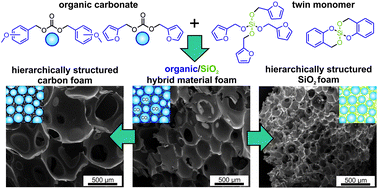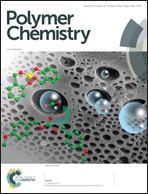Hierarchically structured carbon and silica by chemical foaming†
Abstract
Chemical foaming of organic/silica hybrid materials is performed directly via simultaneous cationic polymerization of the organic carbonates difurfurylcarbonate (DFC), bis(m-methoxybenzyl) carbonate (mC) and bis(p-methoxybenzyl) carbonate (pC) with the twin monomers tetrafurfuryloxysilane (TFOS) and 2,2′-spirobi[4H-1,3,2-benzodioxasiline] (Spiro), respectively. Overall, carbon dioxide gas, the organic resin and silica are produced via step growth polymerization processes, which take place at the same time in the melt of the reactants. The simultaneous polymer formation is ensured because both the polymerizable organic fragments of the twin monomers (TFOS or Spiro) and the corresponding organic carbonate have almost the same aromatic reactivity and thus a homo- or a copolymer is generated. An appropriate surfactant assists the foaming process due to stabilization of the released carbon dioxide bubbles, which forms a macro- and micro-cellular structure. A typical nano-structure, which is known in twin polymerization, is embedded in the foam walls. Consequently, if the chemical transformation of the foamed hybrid materials in silica or carbon foams is performed, micro- and mesopores in the foam walls are achieved. Thus, the fabricated foams have a hierarchically structured pore network.



 Please wait while we load your content...
Please wait while we load your content...